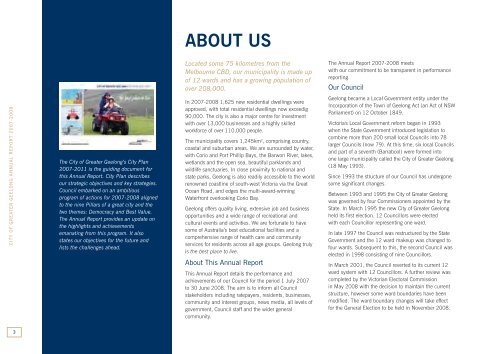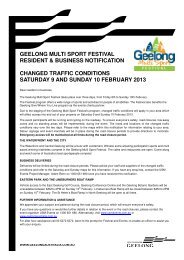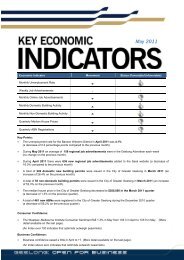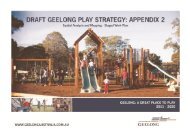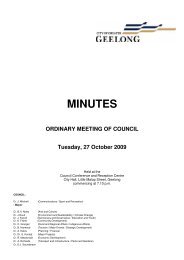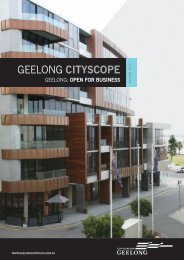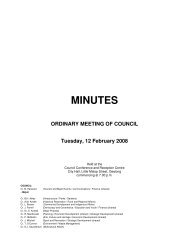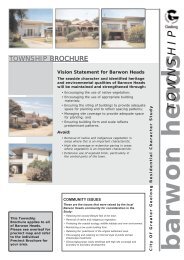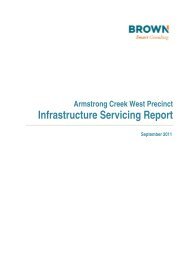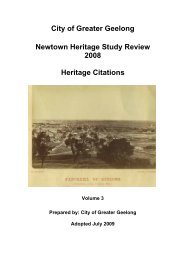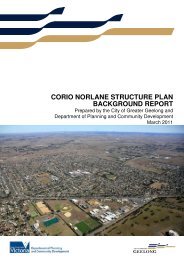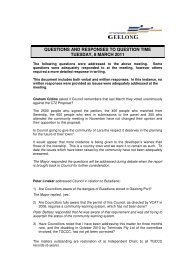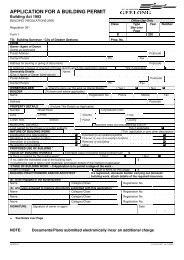ANNUAL REPORT 2007-2008 CITY OF GREATER GEELONG
ANNUAL REPORT 2007-2008 CITY OF GREATER GEELONG
ANNUAL REPORT 2007-2008 CITY OF GREATER GEELONG
Create successful ePaper yourself
Turn your PDF publications into a flip-book with our unique Google optimized e-Paper software.
ABOUT US<br />
Located some 75 kilometres from the<br />
Melbourne CBD, our municipality is made up<br />
of 12 wards and has a growing population of<br />
over 208,000.<br />
The Annual Report <strong>2007</strong>-<strong>2008</strong> meets<br />
with our commitment to be transparent in performance<br />
reporting.<br />
Our Council<br />
<strong>CITY</strong> <strong>OF</strong> <strong>GREATER</strong> <strong>GEELONG</strong> <strong>ANNUAL</strong> <strong>REPORT</strong> <strong>2007</strong>-<strong>2008</strong><br />
The City of Greater Geelong’s City Plan<br />
<strong>2007</strong>-2011 is the guiding document for<br />
this Annual Report. City Plan describes<br />
our strategic objectives and key strategies.<br />
Council embarked on an ambitious<br />
program of actions for <strong>2007</strong>-<strong>2008</strong> aligned<br />
to the nine Pillars of a great city and the<br />
two themes: Democracy and Best Value.<br />
The Annual Report provides an update on<br />
the highlights and achievements<br />
emanating from this program. It also<br />
states our objectives for the future and<br />
lists the challenges ahead.<br />
In <strong>2007</strong>-<strong>2008</strong> 1,625 new residential dwellings were<br />
approved, with total residential dwellings now exceedig<br />
90,000. The city is also a major centre for investment<br />
with over 13,000 businesses and a highly skilled<br />
workforce of over 110,000 people.<br />
The municipality covers 1,245km 2 , comprising country,<br />
coastal and suburban areas. We are surrounded by water,<br />
with Corio and Port Phillip Bays, the Barwon River, lakes,<br />
wetlands and the open sea, beautiful parklands and<br />
wildlife sanctuaries. In close proximity to national and<br />
state parks, Geelong is also readily accessible to the world<br />
renowned coastline of south-west Victoria via the Great<br />
Ocean Road, and edges the multi-award-winning<br />
Waterfront overlooking Corio Bay.<br />
Geelong offers quality living, extensive job and business<br />
opportunities and a wide range of recreational and<br />
cultural events and activities. We are fortunate to have<br />
some of Australia’s best educational facilities and a<br />
comprehensive range of health care and community<br />
services for residents across all age groups. Geelong truly<br />
is the best place to live.<br />
About This Annual Report<br />
This Annual Report details the performance and<br />
achievements of our Council for the period 1 July <strong>2007</strong><br />
to 30 June <strong>2008</strong>. The aim is to inform all Council<br />
stakeholders including ratepayers, residents, businesses,<br />
community and interest groups, news media, all levels of<br />
government, Council staff and the wider general<br />
community.<br />
Geelong became a Local Government entity under the<br />
Incorporation of the Town of Geelong Act (an Act of NSW<br />
Parliament) on 12 October 1849.<br />
Victoria's Local Government reform began in 1993<br />
when the State Government introduced legislation to<br />
combine more than 200 small local Councils into 78<br />
larger Councils (now 79). At this time, six local Councils<br />
and part of a seventh (Barrabool) were formed into<br />
one large municipality called the City of Greater Geelong<br />
(18 May 1993).<br />
Since 1993 the structure of our Council has undergone<br />
some significant changes.<br />
Between 1993 and 1995 the City of Greater Geelong<br />
was governed by four Commissioners appointed by the<br />
State. In March 1995 the new City of Greater Geelong<br />
held its first election. 12 Councillors were elected<br />
with each Councillor representing one ward.<br />
In late 1997 the Council was restructured by the State<br />
Government and the 12 ward makeup was changed to<br />
four wards. Subsequent to this, the second Council was<br />
elected in 1998 consisting of nine Councillors.<br />
In March 2001, the Council reverted to its current 12<br />
ward system with 12 Councillors. A further review was<br />
completed by the Victorian Electoral Commission<br />
in May <strong>2008</strong> with the decision to maintain the current<br />
structure, however some ward boundaries have been<br />
modified. The ward boundary changes will take effect<br />
for the General Election to be held in November <strong>2008</strong>.<br />
3


